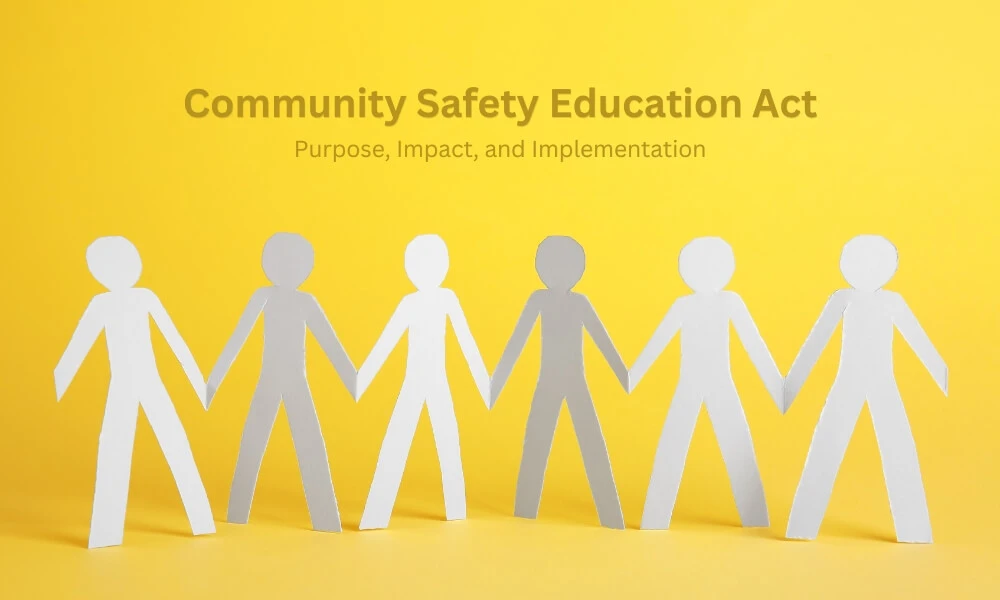In today’s ever-evolving societal landscape, the safety of our communities remains paramount. The Community Safety Education Act stands out as a beacon of proactive strategy among the many legislative tools crafted to uphold this safety. This act, though primarily legal in nature, transcends into the lives of ordinary citizens, ensuring that each person is empowered with knowledge and resources for their own safety and that of their community.
This blog will demystify the Community Safety Education Act, exploring its core purpose, its profound impact on community well-being, and the practical ways it’s brought to life in our institutions and neighborhoods. Whether you’re an educator, a community leader, a concerned citizen, or simply curious, journey with us as we delve into the intricacies of this pivotal piece of legislation and its transformative role in forging safer, more resilient communities.
What is the Community Safety Education Act?
The Community Safety Education Act is legislation designed to bolster safety and accident prevention within communities. It emphasizes the importance of providing safety education by mandating certain institutions, notably schools and youth organizations, to impart this knowledge to their members. The act aims to arm individuals with essential information and skills to help prevent accidents and respond effectively during emergencies. Topics covered might include fire safety, first aid, and emergency preparedness.
In addition to the educational component, the Community Safety Education Act establishes a funding mechanism to support community safety programs and initiatives. This financial provision ensures that communities have adequate resources to promote safety measures, raise public awareness, and potentially support research into novel safety technologies and best practices. The act aims to foster a more informed and safer community environment through these mandates and resources.

What is The Purpose Of The Community Safety Education Act
The Community Safety Education Act serves several core purposes:
1. Promote Safety and Accident Prevention
The primary objective of the Community Safety Education Act is to foster a safe environment where community members are well-informed about potential dangers. A well-educated community is more likely to avoid accidents and mishaps, as they know how to navigate various risks. This aspect of the act is pivotal because when people understand the potential hazards in their surroundings, they can make informed decisions, ensuring their safety and that of others.
2. Mandatory Safety Education in Institutions
Institutions play a significant role in shaping behaviors and transmitting knowledge. The act guarantees a consistent relay of safety principles by making safety education compulsory in schools and youth organizations. This consistent flow of information ensures that every young individual, regardless of where they study or the organizations they are part of, possesses a foundational understanding of safety procedures, best practices, and emergency protocols.
3. Provision of Resources for Community Safety
It’s one thing to mandate education, but ensuring its effective implementation requires resources. This act doesn’t just stop at directives; it offers communities the financial backing to materialize safety initiatives. Funds can be channeled into creating engaging public awareness campaigns, organizing community drills, or establishing local emergency response teams. Furthermore, these resources can support research endeavors, leading to innovative methods and tools prioritizing safety.
4. Foster Collaboration and Community Engagement
A community’s strength lies in its unity. The act underscores the importance of synergy among various local entities – from schools to local governments. This collaborative approach promotes sharing expertise, resources, and strategies, which can significantly amplify the effectiveness of safety measures. When these institutions unite with a common purpose, the entire community benefits from a holistic approach to safety.
5. Raise Awareness of Specific Dangers
Every community is unique and may face its own set of challenges. For instance, an area prone to earthquakes would have different safety concerns than one near a chemical plant. The act is flexible enough to allow communities to customize their safety education based on their specific risks, ensuring that the knowledge imparted is relevant and practical.

6. Establish a Foundation for Continuous Learning
Safety standards and threats are not static; they evolve. Recognizing this, the act promotes an ongoing educational model. This ensures that communities remain updated as new safety challenges arise or as research unveils better safety practices. It’s not just about a one-time education but fostering a lifelong commitment to safety awareness and learning.
7. Support Vulnerable Populations
Everyone has the right to safety, but some groups may require more tailored support. The elderly might need to understand fall prevention, while children might benefit from stranger danger education. Recognizing and addressing these specialized needs ensures that safety education is inclusive and caters to all.
8. Promote Accountability
An important aspect of any directive is accountability. The act establishes a chain of responsibility by clearly defining which institutions are responsible for imparting safety education. This accountability ensures that these institutions remain diligent, continually updating and refining their safety programs.
9. Catalyze Research and Innovation
Beyond immediate education, the act has a far-reaching influence on the future of safety. With resources allocated for research, there’s a strong push for scholars, scientists, and innovators to explore new frontiers in community safety, potentially leading to groundbreaking discoveries that could redefine safety standards globally.
10. Reinforce Cultural Emphasis on Safety
Repeated practices and values shape culture. As safety education becomes commonplace and integrated into daily life, it shapes the community’s culture. This cultural shift is invaluable because when safety becomes a shared value, it’s not just a mandate but a way of life, ensuring that the community remains vigilant and safe for generations.

Impact Of The Community Safety Education Act On Community Safety
The Community Safety Education Act has made a significant impact on community safety in several ways:
1. Enhanced Knowledge and Awareness
One of the most immediate effects of this act is enhancing knowledge and awareness among community members about safety measures. With safety education becoming mandatory in institutions, students and young individuals are better informed about identifying hazards and reacting appropriately in emergencies. This can effectively reduce common accidents due to a lack of knowledge or unawareness.
2. Increased Preparedness
Schools and youth organizations play a crucial role in developing young individuals. Mandating these institutions to provide safety education ensures the next generation is better prepared for emergencies. This increased preparedness benefits the individuals and helps reduce the strain on emergency services, as more people know the basics of first aid and emergency response.
3. Community Empowerment
Providing funding for community safety initiatives empowers communities to take charge of their own safety. Whether organizing community-wide drills, investing in emergency infrastructure, or supporting local organizations that promote safety, the act has provided communities the financial backing they need.
4. Promotion of Research and Technological Advancements
With funds available for research and developing new safety technologies, innovators and researchers have a greater incentive to focus on community safety. This could lead to advancements in technology that can make communities even safer.
5. Strengthened Partnerships
The act fosters collaboration between schools, community organizations, emergency services, and local governments. These partnerships can lead to coordinated efforts in safety campaigns and emergency response planning, making communities more resilient.
6. Cultural Shift
Over time, as safety education becomes a staple in community institutions, there is likely to be a cultural shift toward prioritizing safety. When communities prioritize safety from a young age, it can lead to long-term behavioral changes, contributing to safer communities.
In conclusion, the Community Safety Education Act is a comprehensive approach to bolstering community safety through education, funding, and collaboration. By targeting multiple facets of community safety and emphasizing the importance of preparedness, the act has positioned communities to be safer and more resilient in the face of potential hazards.

Community Safety Education Act Implementation
The success of the Community Safety Education Act rests on its thorough and strategic implementation. Here’s how the act is actualized:
- Centralized Guidelines: The act starts with a clear set of guidelines and standards issued by the relevant governmental body, detailing the specifics of safety education that must be imparted across different communities and institutions.
- Localized Adaptation: While centralized guidelines provide a framework, local governing bodies are responsible for adapting these to their community’s specific needs, ensuring that the education remains relevant.
- Monitoring and Evaluation: Periodic evaluations are essential to gauge the effectiveness of safety programs. Feedback mechanisms are established to ensure continuous improvement.
Roles and Responsibilities of Various Stakeholders
- Law Enforcement: Their role is multifaceted. Firstly, they are the primary enforcers, ensuring institutions comply with the act’s mandates. Additionally, they often serve as educators, conducting workshops and sessions on crime prevention, emergency response, and other safety topics.
- Educational Institutions: Schools, colleges, and other educational entities must integrate safety education into their curriculums. This could range from dedicated safety courses to integrating safety topics into existing subjects. They’re also tasked with holding regular drills and emergency response simulations.
- Community Organizations: These bodies play a pivotal role in raising awareness. They might organize community events, workshops, or forums that discuss local safety issues, solutions, and the act’s objectives. They also act as a bridge, gathering community feedback and liaising with other stakeholders to ensure the act’s successful implementation.

Training Programs or Educational Curriculum Associated with the Act
- Standardized Safety Modules: Centralized bodies, in collaboration with experts, develop standardized educational modules covering universal safety topics – like first aid, fire safety, and basic emergency response.
- Specialized Training Programs: Depending on the community’s needs, specialized training programs might be rolled out. For example, specific earthquake safety or flood preparedness modules could exist in areas prone to natural disasters.
- Train the Trainer Programs: Educators must be well-trained to ensure effective dissemination of safety education. ‘Train the trainer’ programs are developed to equip teachers, community leaders, and other stakeholders with the knowledge and skills to impart safety education effectively.
- Interactive Workshops: Instead of traditional lecture-based education, interactive workshops, including role-playing, simulations, and hands-on activities, are encouraged to make safety education engaging and memorable.
- Continuous Education Programs: Recognizing that safety standards and knowledge evolve, there are continuous education programs designed to update stakeholders on new safety findings, technologies, and best practices.
Through centralized guidance, localized execution, and the collective efforts of various stakeholders, the Community Safety Education Act is not just a piece of legislation but a living commitment to ensuring community safety.
Conclusion
The Community Safety Education Act stands as a testament to the collective commitment of society to foster safer environments for its members. By establishing a framework for education, collaboration, and resource allocation, this act underlines the belief that community safety is not just the responsibility of a few but a shared duty of all. From schools to community organizations, from law enforcement to individual citizens, we each play a pivotal role in ensuring the safety net this act promises remains robust.
One thing becomes abundantly clear as we reflect on its purpose, impact, and implementation: a well-informed, united community is our best defense against unforeseen challenges. The Community Safety Education Act isn’t just about rules or mandates; it’s about nurturing a culture where safety is interwoven into the very fabric of our daily lives. It reminds us that, with knowledge, collaboration, and vigilance, we can build safe communities and thrive amidst adversity.

